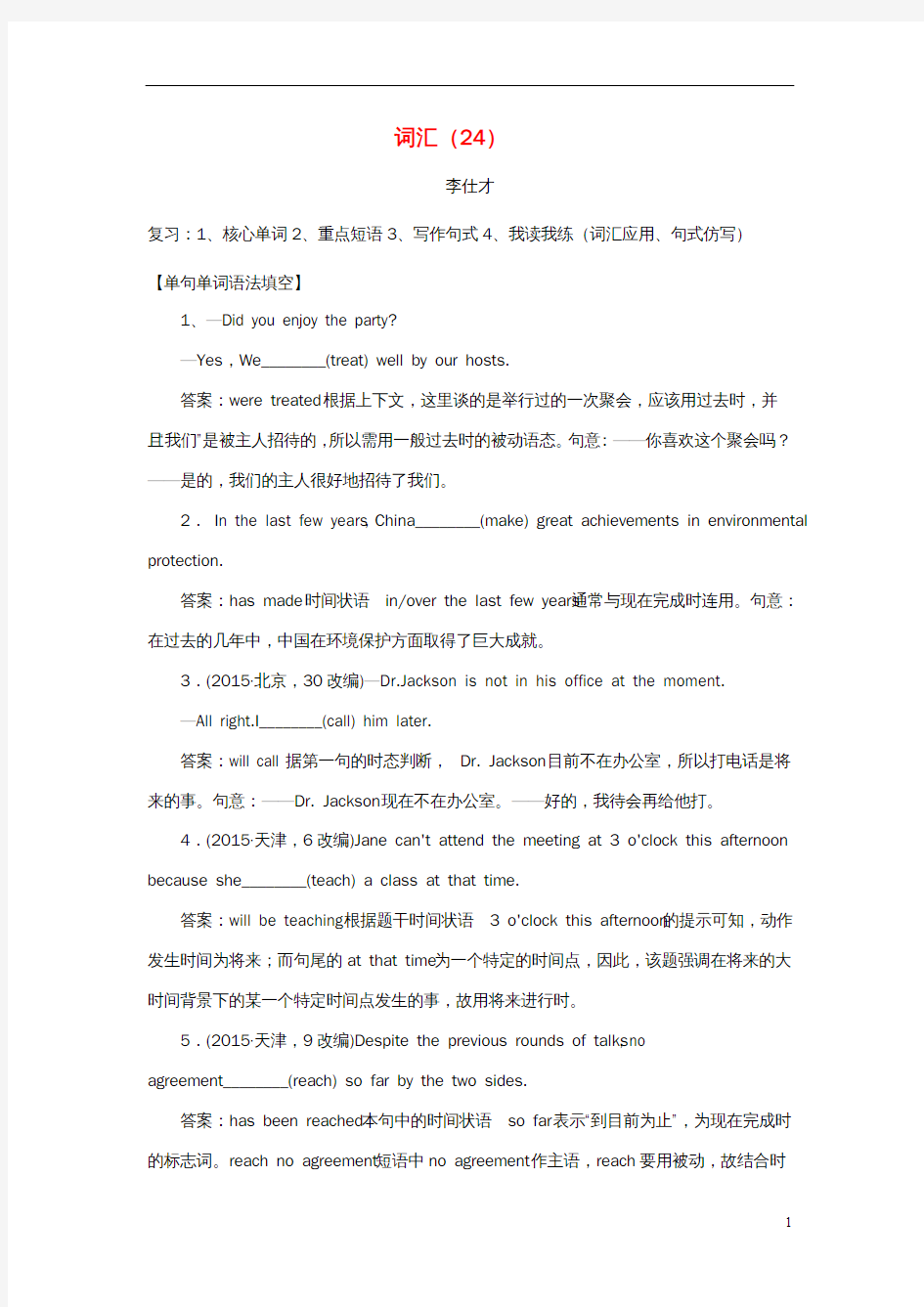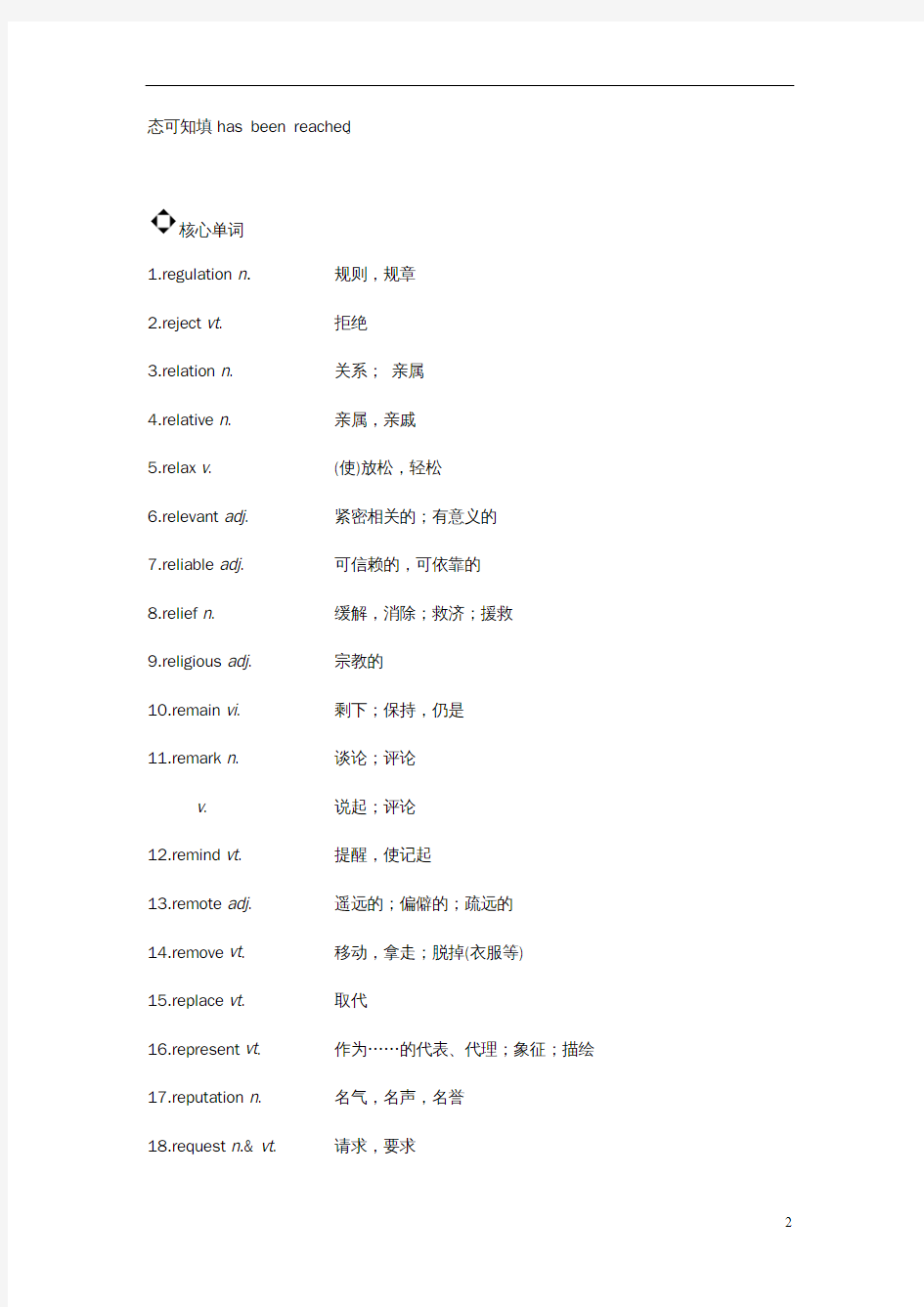

词汇(24)
李仕才
复习:1、核心单词2、重点短语3、写作句式4、我读我练(词汇应用、句式仿写)
【单句单词语法填空】
1、—Did you enjoy the party?
—Yes,We________(treat) well by our hosts.
答案:were treated 根据上下文,这里谈的是举行过的一次聚会,应该用过去时,并且“我们”是被主人招待的,所以需用一般过去时的被动语态。句意:——你喜欢这个聚会吗?——是的,我们的主人很好地招待了我们。
2.In the last few years,China________(make) great achievements in environmental protection.
答案:has made 时间状语in/over the last few years通常与现在完成时连用。句意:在过去的几年中,中国在环境保护方面取得了巨大成就。
3.(2015·北京,30改编)—Dr.Jackson is not in his office at the moment.
—All right.I________(call) him later.
答案:will call 据第一句的时态判断,Dr. Jackson目前不在办公室,所以打电话是将来的事。句意:——Dr. Jackson现在不在办公室。——好的,我待会再给他打。
4.(2015·天津,6改编)Jane can't attend the meeting at 3 o'clock this afternoon because she________(teach) a class at that time.
答案:will be teaching 根据题干时间状语3 o'clock this afternoon的提示可知,动作发生时间为将来;而句尾的at that time为一个特定的时间点,因此,该题强调在将来的大时间背景下的某一个特定时间点发生的事,故用将来进行时。
5.(2015·天津,9改编)Despite the previous rounds of talks,no
agreement________(reach) so far by the two sides.
答案:has been reached 本句中的时间状语so far表示“到目前为止”,为现在完成时的标志词。reach no agreement短语中no agreement作主语,reach要用被动,故结合时
态可知填has been reached。
核心单词
1.regulation n. 规则,规章
2.reject vt. 拒绝
3.relation n. 关系;亲属
4.relative n. 亲属,亲戚
5.relax v. (使)放松,轻松
6.relevant adj. 紧密相关的;有意义的
7.reliable adj. 可信赖的,可依靠的
8.relief n. 缓解,消除;救济;援救
9.religious adj. 宗教的
10.remain vi. 剩下;保持,仍是
11.remark n. 谈论;评论
v. 说起;评论
12.remind vt. 提醒,使记起
13.remote adj. 遥远的;偏僻的;疏远的
14.remove vt. 移动,拿走;脱掉(衣服等)
15.replace vt. 取代
16.represent vt. 作为……的代表、代理;象征;描绘
17.reputation n. 名气,名声,名誉
18.request n.& vt. 请求,要求
19.requirement n. 需要;要求;必要的条件
20.research n.& v. 研究,调查
21.resemble vt. 相似,类似,看起来像(不用于进行时)
22.result n. 结果,效果
23.revision n. 复习,温习
24.reserve n. 保留;储备;替补队员;自然保护区 vt. 预订;储备;保留
25.resign v. 辞职
重点短语
1.make full/good use of 充分利用put...to use 加以使用
come into use 开始被使用
be of great use 很有用
It is no use/useless doing sth 做某事是没用的2.make up 组成;化妆;打扮;补充;编造make up for 弥补;补偿
make room for 给……腾地方
make up one’s mind 下决心
make one’s way 排除困难前进
make progress 进步
make a promise 许诺
make a living 谋生
make out 认出,理解
make it 成功;及时到达
be made up of 由……组成
【阅读理解】
Chinese paper cutting or "jianzhi" is the art of cutting paper designs, and the cut-outs are also used to decorate doors and windows, so they are sometimes called "chuang hua". Paper cutting has long been a symbol of Eastern charm.
There are symmetrical(对称的)designs that are usually created by some folding and cutting. When unfolded, it forms a symmetrical design. Chinese cut-outs are normally symmetrical and are usually in an even number series of 2, 4, 24,etc.
The oldest surviving paper cut-out is a symmetrical circle from the early 6th century found in Xinjiang, China. From the 7th to 13th century, paper cutting became popular especially during Chinese festivals. The art spread to the rest of the world in the 14th century. Throughout the Qing Dynasty many paper cutting skills were developed including drafting and the use of smoked papers. By the end of the Qing ruling, however, paper cutting was once on the decline because new art forms were being introduced. The Republic of China later tried to revive the art in the 1980s.
Today, paper cut-outs are chiefly decorative. They decorate walls, windows, doors, columns, mirrors, lamps and lanterns in homes and are also used on presents or are given as gifts themselves. Entrances decorated with paper cut-outs are supposed to bring good luck. Paper cut-outs used to be used as patterns, especially for embroidery(刺绣).
There are two methods of manufacture: one uses scissors, the other uses knives. In
the scissor method, several pieces of paper — up to eight — are fastened together. The image is then cut with sharp, pointed scissors. Knife cuttings are fashioned by putting several paper on a relatively soft foundation consisting of a mixture of oil and ashes. Skilled crafters can even cut out different drawings freely without stopping.
1.When can the existing oldest paper cutting date back to?
A. about 1 500 years ago.
B. about 1 600 years ago.
C. about 1 400 years ago.
D. about 600 years ago.
2.The underlined word "revive" in Paragraph 3 can be replaced by "_______".
A. survive
B. restore
C. copy
D. fix
3.Which of the following words can best summarize the last paragraph?
A. History.
B. Origin.
C. Uses.
D. Process.
4.What may be the best title of the text?
A. Paper — the Eastern Charm
B. The History of Paper Cutting
C.A Brief Introduction to Paper Cutting
D. Paper Cutting — Unbelievable Skilled Crafters
【文章大意】本文是一篇说明文。中国的剪纸艺术源远流长,距今已有1 500多年的历史。如今的剪纸主要用于装饰。剪纸过程简单但具有一定的文化特色。
1.A 【解析】细节理解题。根据文章第三段的首句中的关键信息"The oldest surviving paper
cut-out...from the early 6th century found in Xinjiang, China"可知,该艺术始于六世纪早
期,即500年左右,故用2017年减去500年,即可推知距今约1 500年。
3.D 【解析】段落大意题。最后一段介绍了剪纸的两种方法,具体使用什么工具和怎样操作。
由此可推知本段讲的是剪纸的过程,故用process概括此段较为合适。
4.C 【解析】标题归纳题。全篇从中国剪纸艺术的历史、用途以及过程等全方位阐述了Paper
Cutting,故用A Brief Introduction to Paper Cutting作为文章标题最合适。
写作句式
虚拟语气
1.(2015·安徽高考书面表达)If I could interview him,I would ask him what made him an astronaut and how he was trained.
如果我可以采访他,我会问他是什么使他成为了一名宇航员及他是如何训练的。
2.But for your advice, I would have failed.
如果不是你的建议,我会失败的。
3.It is time that we human beings took/should take proper measures to keep the balance of nature.
该是我们人类采取适当的措施来维护生态平衡的时候了。
我读我练
Ⅰ.词汇应用
1.Please remind(提醒) me to write an e-mail to my mother tomorrow, for it’s her birthday.
2.The school, more than 90 percent of whose graduates are usually admitted into key
universities, enjoys an excellent reputation (名声).
3.You can get plenty of valuable information from some reliable (rely)sources.
4.He often says that he doesn’t believe in any religion (religious) and only believes in himself.
5.You cannot choose what you are given, but you can choose how you make__use__of (利用) it.
6.Now many girls like to make__up (化妆) when they are still quite young.
Ⅱ.句式仿写
1.我相信,如果你是我,你会做出相同的选择。
(2013·山东高考写作)I believe that if you were me, you_would_make_the_same_choice.
2.没有你的帮助,我无论如何也不会成功。
Without__your__help,__I wouldn’t have succeeded anyway.
3.是我们致力于环境保护和生态改善的时候了。
It’s high time that we__devoted__ourselves__to__environmental__protection and ecological improvement.
【练习】
I usually go to school by bike.And this morning I went on foot.On the way to school,I happen to witness an accident.A middle-aged woman was knocked down by a car while crosses the street.Seeing that was happening on the scene,I made rush for the woman to help.One passer-by got out of his cellphone and called the police.I helped to carry the woman to safe and dress her wound. Around ten minutes late, an ambulance arrived and took him to hospital.I continued my way to school,feeling happily that I could offer some help in time.
【答案】
I usually go to school by bike.And
But
this morning I went on foot.On the way to school,I happen
happened
to witness an accident.A middle-aged woman was knocked down by a car while
crosses crossing the street.Seeing that
what
was happening on the scene,I made ∧a rush for the woman
to help.One passer-by got out ﹨o f his cellphone and called the police.I helped to carry the
woman to safe
safety and dress her wound. Around ten minutes late
later
,an ambulance arrived and
took him
her to hospital.I continued my way to school,feeling happily
happy
that I could offer some help
in time.
第一处:And→But。考查连词。前后句之间是转折关系,故用But。
第二处:happen→happened。考查时态。根据上文中的“I went on foot”可知,此处描述的是发生在过去的事情,应该用一般过去时。
第三处:crosses→crossing。考查非谓语动词。分析句子结构可知,cross与A middle-aged woman之间是逻辑上的主谓关系,故应用现在分词形式。
第四处:that→what。考查名词性从句。这里指“看到现场发生的事情”。此处在句中引导宾语从句,且在从句中作主语,表示“……的事情”,故用what。
第五处:rush前加a。考查冠词。此处指作者冲向那位女士以提供帮助。make a rush for“冲向,奔向”是固定搭配。
第六处:删除out后的of。考查固定搭配。一位路人拿出他的手机并给警察打了电话。get“取来,拿来”,是及物动词,其后可直接接宾语;out在此为副词。而get out of sth.意为“离开(某地),摆脱,放弃”,显然不符合此处的语境。故of多余。
第七处:safe→safety。考查名词。此处充当介词的宾语,应该用名词形式。safety“安全的地方”。
第八处:late→later。考查副词。虽然late和later都可用作副词,但前者表示“迟,晚”,后者表示“后来,随后”。根据句意可知,应将late改为later。
第九处:him→her。考查代词。此处指的是救护车将那个受伤的女士带去了医院,故应用her。
第十处:happily→happy。考查形容词。feel是系动词,其后应用形容词作表语。